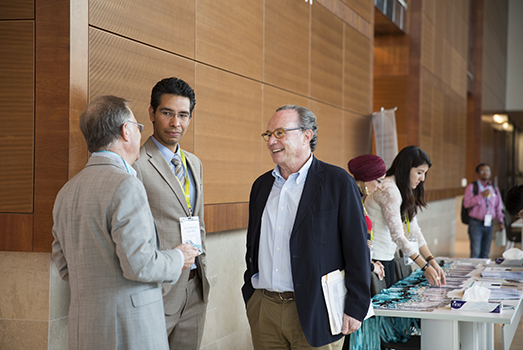Conference sheds light on hydrophobic interfaces

The University’s Water Desalination and Reuse Center (WDRC) hosted the KAUST International Conference on Physics and Chemistries at Hydrophobic Interfaces from February 14 to 17.
The event included presentations by 30 renowned experimentalists and theorists from around the world. Thirty graduate students and postdoctoral fellows also presented research posters and joined the discussions. Researchers from regional universities, such as KFUPM and KAU, along with WDRC’s industrial partners Saudi Aramco, Schlumberger, the Saudi Basic Industries Corporation (SABIC) and Saudi Membrane Distillation Desalination also attended.
Participants shared insights on the physical, chemical and biological aspects of hydrophobic interactions, including short- and long-range forces, hydrogen bonding, ion adsorption at the air-water interface, the molecular structuring of water, ATP synthesis, density fluctuations at the surface of water, nanoscale bubbles, specific ion effects and rates of interfacial reactions.
“Hydrophobic interactions underlie numerous natural and industrial processes, including flow through aquaporins, the cleaning action of shampoos and detergents, oil recovery and water desalination,” said Himanshu Mishra, KAUST assistant professor of environmental science and engineering and conference organizer.
“In fact, wherever you go on the planet and whatever scale you choose to look at, you find interfaces of water with hydrophobic medial; for example, tiny cloud droplets, the surface of the ocean and wax-coated leaves of plants. However, despite their importance on both the nano- and macro-scales, a comprehensive understanding of hydrophobic interactions remains elusive,” he continued. “We organized the conference to identify key challenges in the field and to form new alliances—e.g. between experimentalists and theorists—to surmount them.”
Mishra and Dr. Naval Subramanian, conference coordinator and a researcher in Mishra’s group, thanked the KAUST Office of Sponsored Research and the KAUST Industry Collaboration Program (KICP) from the Industry Engagement Office for their support in organizing the conference.
“The four days of the conference provided invaluable insights into the diversity of new experimental and intellectual approaches, raised new questions and—most importantly—led to new long-term collaborations,” Mishra said.
The University’s Water Desalination and Reuse Center (WDRC) hosted the KAUST International Conference on Physics and Chemistries at Hydrophobic Interfaces from February 14 to 17.
The event included presentations by 30 renowned experimentalists and theorists from around the world. Thirty graduate students and postdoctoral fellows also presented research posters and joined the discussions. Researchers from regional universities, such as KFUPM and KAU, along with WDRC’s industrial partners Saudi Aramco, Schlumberger, the Saudi Basic Industries Corporation (SABIC) and Saudi Membrane Distillation Desalination also attended.
Participants shared insights on the physical, chemical and biological aspects of hydrophobic interactions, including short- and long-range forces, hydrogen bonding, ion adsorption at the air-water interface, the molecular structuring of water, ATP synthesis, density fluctuations at the surface of water, nanoscale bubbles, specific ion effects and rates of interfacial reactions.
“Hydrophobic interactions underlie numerous natural and industrial processes, including flow through aquaporins, the cleaning action of shampoos and detergents, oil recovery and water desalination,” said Himanshu Mishra, KAUST assistant professor of environmental science and engineering and conference organizer.
“In fact, wherever you go on the planet and whatever scale you choose to look at, you find interfaces of water with hydrophobic medial; for example, tiny cloud droplets, the surface of the ocean and wax-coated leaves of plants. However, despite their importance on both the nano- and macro-scales, a comprehensive understanding of hydrophobic interactions remains elusive,” he continued. “We organized the conference to identify key challenges in the field and to form new alliances—e.g. between experimentalists and theorists—to surmount them.”
Mishra and Dr. Naval Subramanian, conference coordinator and a researcher in Mishra’s group, thanked the KAUST Office of Sponsored Research and the KAUST Industry Collaboration Program (KICP) from the Industry Engagement Office for their support in organizing the conference.
“The four days of the conference provided invaluable insights into the diversity of new experimental and intellectual approaches, raised new questions and—most importantly—led to new long-term collaborations,” Mishra said.

